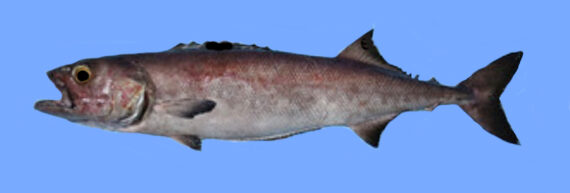Oilfish, Ruvettus pretiosus
 Oilfish, Ruvettus pretiosus. Fish provided by the commercial fishermen of the greater Los Cabos area, Baja California Sur, February 2011. Length: 1.52 m (5 feet 0 inches).
Oilfish, Ruvettus pretiosus. Fish provided by the commercial fishermen of the greater Los Cabos area, Baja California Sur, February 2011. Length: 1.52 m (5 feet 0 inches).
The Oilfish, Ruvettus pretiosus, is a member of the Snake Mackerel or Gempylidae Family, and is known in Mexico as escolar clavo. Globally, the Gempylidae Family includes the snake mackerels, oilfish, escolares, and cutlassfish with twenty-four members placed in sixteen genera. There is only one species in the Ruvettus Genus, the species described herein, which is found in all Mexican waters of the Atlantic Ocean and along the west coast of the Baja south to Magdalena Bay in the Pacific Ocean.
The Oilfish has a very elongated, slender, fusiform body that is slightly compressed. They are a uniform brown to dark brown with their pectoral and pelvic fins tipped in black. Juveniles have anal fins and a second dorsal fin with white margins. Their head is pointed with large circular eyes with the large mouth opening at the fronts equipped with one row of large teeth and canines at the front. Their anal fin has 15 to 18 rays with 2 finlets behind; their caudal fin is deeply forked; their first dorsal fin has 13 to 15 spines and is long and low; their second dorsal fin has 15 to 18 rays and a short base followed by 2 finlets; and their pelvic fins have 1 spine and 5 rays and are well developed. They are covered with rough skin and smooth scales with rows of small tubercles in between the scales. The lateral line is obscure and is slightly cured over the pectoral fins and straight to the caudal peduncle. The mid-belly has a keel of bony plates.
The Oilfish is an oceanic pelagic species that migrate far off shore that are found as solitary individuals or in pairs near the sea floor at depths between 100 m (330 feet) and 800 m (2,625) feet. They reach a maximum 3.05 m (10 feet 0 inches) in length and 63.5 kg (140 lbs) in weight. As of January 1, 2024, the International Game Fish Association world record stood at 63.50 kg (140 lbs) with the fish caught in coastal waters off New Zealand in March 2016. They consume cephalopods, crustaceans, and fish. The Oilfish is poorly studied with very limited information available about their lifestyle and behavioral patterns including specific details on age, growth, longevity, movement patterns, diet, habitat use, and reproduction. The Oilfish is a resident of all Mexican waters of the Atlantic Ocean including the Gulf of the Mexico and the Caribbean; in the Pacific Ocean they are found along the west coast of Baja north of Magdalena Bay.
The Oilfish can be confused with a series of fish from the Atlantic including the American Sackfish, Neoepinnula americana (deeper first dorsal fin with 16 spines), the Domine Escolar, Epinnula magistralis (smooth skin, deeper first dorsal fin), and the Escolar, Lepidocybium flavobrunneum (8 to 11 first dorsal spines) as well as a series of fish from the Pacific including the the Escolar, Lepidocybium flavobrunneum (8 to 11 first dorsal spines) and the Wahoo, Acanthocybium solandri (sides with blue bars).
From a conservation perspective the Oilfish is currently considered to be of Least Concern with stable, widely distributed populations. They are of limited interest as a human food fish and the flesh is oily and is not easily digested. In Japan they are marketed fresh and processed into fishmeal. They are pursued at a nominal level by recreational anglers as a game fish. They are caught in abundance as a bycatch of both the swordfish and tuna longline fisheries.